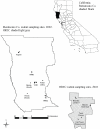Transmission cycles of Borrelia burgdorferi and B. bissettii in relation to habitat type in northwestern California
- PMID: 20514140
- PMCID: PMC2876337
- DOI: 10.3376/038.034.0110
Transmission cycles of Borrelia burgdorferi and B. bissettii in relation to habitat type in northwestern California
Abstract
This study was undertaken to determine which rodent species serve as primary reservoirs for the Lyme disease spirochete Borrelia burgdorferi in commonly occurring woodland types in inland areas of northwestern California, and to examine whether chaparral or grassland serve as source habitats for dispersal of B. burgdorferi- or B. bissettii-infected rodents into adjacent woodlands. The western gray squirrel (Sciurus griseus) was commonly infected with B. burgdorferi in oak woodlands, whereas examination of 30 dusky-footed woodrats (Neotoma fuscipes) and 280 Peromyscus spp. mice from 13 widely spaced Mendocino County woodlands during 2002 and 2003 yielded only one infected woodrat and one infected deer mouse (P. maniculatus). These data suggest that western gray squirrels account for the majority of production by rodents of fed Ixodes pacificus larvae infected with B. burgdorferi in the woodlands sampled. Infections with B. burgdorferi also were rare in woodrats (0/47, 0/3) and mice (3/66, 1/6) captured in chaparral and grassland, respectively, and therefore these habitats are unlikely sources for dispersal of this spirochete into adjacent woodlands. On the other hand, B. bissettii was commonly detected in both woodrats (22/47) and mice (15/66) in chaparral. We conclude that the data from this and previous studies in northwestern California are suggestive of a pattern where inland oak-woodland habitats harbor a B. burgdorferi transmission cycle driven primarily by I. pacificus and western gray squirrels, whereas chaparral habitats contain a B. bissettii transmission cycle perpetuated largely by I. spinipalpis, woodrats and Peromyscus mice. The dominant role of western gray squirrels as reservoirs of B. burgdorferi in certain woodlands offers intriguing opportunities for preventing Lyme disease by targeting these animals by means of either host-targeted acaricides or oral vaccination against B. burgdorferi.
Keywords: Borrelia bissettii; Borrelia burgdorferi; California; Ixodes pacificus; Lyme disease; rodent reservoirs.
Figures


Similar articles
-
Vector competence of Ixodes pacificus and I. spinipalpis (Acari: Ixodidae), and reservoir competence of the dusky-footed woodrat (Neotoma fuscipes) and the deer mouse (Peromyscus maniculatus), for Borrelia bissettii.J Med Entomol. 2003 May;40(3):311-20. doi: 10.1603/0022-2585-40.3.311. J Med Entomol. 2003. PMID: 12943110
-
Sylvatic maintenance of Borrelia burgdorferi (Spirochaetales) in Northern California: untangling the web of transmission.J Med Entomol. 2006 Jul;43(4):743-51. doi: 10.1603/0022-2585(2006)43[743:smobbs]2.0.co;2. J Med Entomol. 2006. PMID: 16892634
-
Western gray squirrel (Rodentia: Sciuridae): a primary reservoir host of Borrelia burgdorferi in Californian oak woodlands?J Med Entomol. 2005 May;42(3):388-96. doi: 10.1093/jmedent/42.3.388. J Med Entomol. 2005. PMID: 15962792
-
The role of Ixodes scapularis, Borrelia burgdorferi and wildlife hosts in Lyme disease prevalence: A quantitative review.Ticks Tick Borne Dis. 2018 Jul;9(5):1103-1114. doi: 10.1016/j.ttbdis.2018.04.006. Epub 2018 Apr 16. Ticks Tick Borne Dis. 2018. PMID: 29680260 Review.
-
Rodent-targeted approaches to reduce acarological risk of human exposure to pathogen-infected Ixodes ticks.Ticks Tick Borne Dis. 2023 Mar;14(2):102119. doi: 10.1016/j.ttbdis.2023.102119. Epub 2023 Jan 14. Ticks Tick Borne Dis. 2023. PMID: 36680999 Free PMC article. Review.
Cited by
-
Population genetics, taxonomy, phylogeny and evolution of Borrelia burgdorferi sensu lato.Infect Genet Evol. 2011 Oct;11(7):1545-63. doi: 10.1016/j.meegid.2011.07.022. Epub 2011 Aug 5. Infect Genet Evol. 2011. PMID: 21843658 Free PMC article. Review.
-
Blocking pathogen transmission at the source: reservoir targeted OspA-based vaccines against Borrelia burgdorferi.Front Cell Infect Microbiol. 2014 Sep 26;4:136. doi: 10.3389/fcimb.2014.00136. eCollection 2014. Front Cell Infect Microbiol. 2014. PMID: 25309883 Free PMC article. Review.
-
Differences in prevalence of Borrelia burgdorferi and Anaplasma spp. infection among host-seeking Dermacentor occidentalis, Ixodes pacificus, and Ornithodoros coriaceus ticks in northwestern California.Ticks Tick Borne Dis. 2010 Dec;1(4):159-67. doi: 10.1016/j.ttbdis.2010.09.004. Ticks Tick Borne Dis. 2010. PMID: 21359090 Free PMC article.
-
Bacterial microbiomes of Ixodes scapularis ticks collected from Massachusetts and Texas, USA.BMC Microbiol. 2019 Jun 24;19(1):138. doi: 10.1186/s12866-019-1514-7. BMC Microbiol. 2019. PMID: 31234774 Free PMC article.
-
Borrelia burgdorferi sensu lato spirochetes in wild birds in northwestern California: associations with ecological factors, bird behavior and tick infestation.PLoS One. 2015 Feb 25;10(2):e0118146. doi: 10.1371/journal.pone.0118146. eCollection 2015. PLoS One. 2015. PMID: 25714376 Free PMC article.
References
-
- Brown RN, Lane RS. Lyme disease in California: A novel enzootic transmission cycle of Borrelia burgdorferi. Science. 1992;256:1439–1442. - PubMed
-
- Brown RN, Peot MA, Lane RS. Sylvatic maintenance of Borrelia burgdorferi (Spirochaetales) in northern California: Untangling the web of transmission. J. Med. Entomol. 2006;43:743–751. - PubMed
-
- Burgdorfer W, Lane RS, Barbour AG, Gresbrink RA, Anderson JR. The western black-legged tick, Ixodes pacificus: A vector of Borrelia burgdorferi. Am. J. Trop. Med. Hyg. 1985;34:925–930. - PubMed
-
- Burkot TR, Clover JR, Happ CM, DeBess E, Maupin GO. Isolation of Borrelia burgdorferi from Neotoma fuscipes, Peromyscus maniculatus, Peromyscus boylii, and Ixodes pacificus in Oregon. Am. J. Trop. Med. Hyg. 1999;60:453–457. - PubMed
Publication types
MeSH terms
Grants and funding
LinkOut - more resources
Full Text Sources
Medical
Miscellaneous
